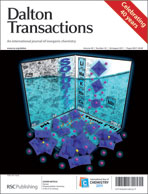A series of mononuclear iron(III) complexes of the type [Fe(L)Cl3], where L is a systematically modified N2O or N3O ligand with a methoxyethyl/tetrahydrofuryl ether oxygen donor atom, have been isolated and studied as models for catechol dioxygenases. The X-ray crystal structures of [Fe(L2)Cl3] 2, [Fe(L6)Cl3] 6, [Fe(L5)(TCC)Cl] 5a, where H2TCC = tetrachlorocatechol, [Fe(L6)(TCC)Br] 6a, and the μ-oxo dimer [{Fe(L6)Cl}2O](ClO4)26b have been successfully determined. In [Fe(L2)Cl3] 2 the N2O ligand is facially coordinated to iron(III) through the pyridine and secondary amine nitrogen atoms and the tetrahydrofuryl oxygen atom. In [Fe(L6)Cl3] 6, [Fe(L5)(TCC)Cl] 5a and [Fe(L6)(TCC)Br] 6a the N3O donor ligands L5 and L6 act as a tridentate N3 donor ligand coordinated through two pyridine and one secondary amine nitrogen atoms, whereas the ether oxygen is not coordinated. The spectral and electrochemical properties of the adducts [Fe(L)(DBC)Cl] of 1–8, where H2DBC = 3,5-di-tert-butylcatechol, in DMF and their solvated adduct species [Fe(L)(DBC)(Sol)]+, where Sol = DMF/H2O, generated in situ in dichloromethane, respectively, have been investigated. The product analysis demonstrates that the adducts [Fe(L)(DBC)Cl] effect cleavage of catechol in the presence of O2 in DMF to give mainly the intradiol (I) product with a small amount of the extradiol (E) product (E/I, 0.2:1–0.7:1). Interestingly, the solvated species [Fe(L)(DBC)(Sol)]+ derived from 1–4 cleave H2DBC to provide mainly the extradiol cleavage products with lower amounts of intradiol products (E/I, 2.3:1–4.3:1) in dichloromethane. In contrast, the solvated species [Fe(L)(DBC)(Sol)]+ derived from 5–8 cleave H2DBC to provide both extradiol and intradiol products (E/I, 0.6:1–2.3:1) due to the involvement of the ether oxygen donor of the methoxyethyl/tetrahydrofuryl arm in the coordination to iron(III) upon removal of a chloride ion.


 Please wait while we load your content...
Please wait while we load your content...